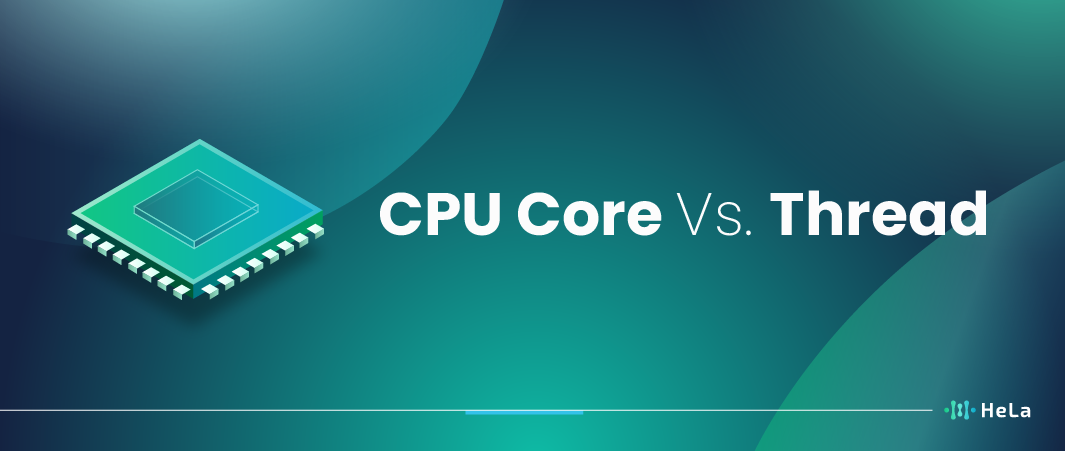In the intricate realm of computing architecture, where the orchestration of billions of transistors dictates the speed and efficiency of modern processors, the concepts of “cores” and “threads” stand as cornerstone principles. Within the intricate circuitry of a CPU, cores represent the physical processing units responsible for executing instructions and performing computations. Imagine them as the individual engines powering a machine, each capable of handling specific tasks independently. Conversely, threads are virtualized execution paths within each core, allowing for the concurrent processing of multiple tasks.
Picture them as the intricate network of pipelines through which instructions flow, optimizing the utilization of computational resources and enhancing overall efficiency. While these terms may seem synonymous at first glance, delving deeper unveils a rich tapestry of distinctions that profoundly influence the performance and capabilities of modern computing systems. Understanding the nuances between cores and threads not only sheds light on the inner workings of CPUs but also provides critical insights into optimizing software design, resource allocation, and system performance.
What is CPU Cores?
CPU cores is fundamental components within a computer’s central processing unit (CPU). These cores can be likened to the processing hubs or the brains of the computer. Each CPU core functions as an independent physical processing unit with the capability to execute instructions autonomously. In other words, it can perform calculations and carry out tasks on its own. The more CPU cores a processor has, the greater the number of tasks a computer can manage simultaneously.
When you’re using your computer and running applications or tasks, these are allocated to one or more CPU cores for processing. The quantity of CPU cores in your processor plays a pivotal role in determining how many tasks your computer can juggle at the same time. For instance, a quad-core processor consists of four cores, allowing it to handle four tasks concurrently.
This property is particularly advantageous for multitasking, as it leads to smoother performance when simultaneously running multiple applications or handling various tasks. Whether you’re gaming, video editing, or working on numerous projects, a higher core count can greatly enhance your computer’s ability to manage these tasks efficiently.
Definition of Hyper-Threading and Threads
Hyper-Threading is a technology commonly found in modern processors, especially those from Intel. It is a feature that enables a single physical CPU core to handle multiple threads simultaneously. Threads, in this context, refer to virtual processing units created by Hyper-Threading.
Also Read: Best Next-Gen Layer 1 to Watch in 2023
In more detail, Hyper-Threading works by allowing a single CPU cores to execute instructions from multiple threads in a way that makes it appear as though you have more physical cores than you actually do. Each thread is a separate sequence of instructions that can be executed independently, and Hyper-Threading enables the CPU to switch between these threads rapidly. This concurrent execution of threads enhances the CPU’s multitasking capabilities, as it can perform multiple tasks in parallel.
For instance, consider a dual-core processor with Hyper-Threading. While it physically has only two cores, it can effectively handle four threads concurrently, thanks to Hyper-Threading. This technology is particularly advantageous for applications that can take advantage of multiple threads, such as video editing, 3D rendering software, or other highly parallelizable tasks. It allows these applications to run more efficiently and take full advantage of the available CPU resources, resulting in improved performance and reduced processing times.
The Key Differentiators CPU Cores and Threads

The ongoing debate about the importance of CPU cores versus threads is central to optimizing your computer’s performance. Your choice between cores and threads depends on the nature of the tasks you typically perform, and there are key differentiators to consider:
Task Nature
- Parallelizable Tasks: If your work involves tasks that can be efficiently divided into smaller, independent subtasks and executed simultaneously, then having more threads is highly beneficial. This is particularly relevant for activities such as video editing, 3D rendering, scientific simulations, and complex data analysis. In these cases, a CPU with a higher thread count, often facilitated by technologies like Hyper-Threading, can significantly reduce processing times and lead to increased productivity. When you have numerous threads available, the workload can be distributed across them, resulting in faster task completion.
- Single-Threaded Tasks: Conversely, if your activities rely primarily on the performance of a single core, such as older video games, certain office applications, or web browsing, then a CPU with higher clock speeds and superior single-core performance becomes more crucial. In these situations, it’s not the number of threads that matter, but rather the raw processing power of individual cores. Older software and games are often designed to run on a single thread, so a CPU with a high clock speed and strong single-core performance will provide a better experience.
Multi-Threaded Performance
- More Threads: For tasks that efficiently utilize multiple threads, CPUs with a higher thread count shine. Technologies like Hyper-Threading allow each physical core to handle multiple threads simultaneously, effectively increasing the CPU’s capacity to perform multiple tasks in parallel. This is particularly advantageous for professionals engaged in tasks like video editing or 3D rendering, where the ability to divide the workload across multiple threads can lead to significantly reduced rendering times and increased overall efficiency.
- Fewer Threads: On the other hand, for tasks that do not efficiently utilize multiple threads, a CPU with fewer cores but higher per-core performance is a better choice. Such CPUs excel in single-threaded applications, where the performance of a single core is paramount. If you’re mainly using older software or engaging in activities that aren’t optimized for multi-threading, a CPU with fewer but faster cores will deliver a more satisfying user experience.
The cores versus threads decision is not one-size-fits-all. It’s crucial to assess your computing needs and strike the right balance between cores and threads to achieve the best performance for your unique set of tasks.
The Difference Between CPU Cores and Threads

To illustrate the difference between CPU cores and threads, let’s consider a few real-world scenarios where these concepts play a crucial role in computing and performance optimization:
Gaming
In the world of gaming, CPU cores and threads play a vital role in delivering a smooth and immersive experience. Modern video games demand significant computational power to render realistic graphics, simulate complex physics, and execute game logic. CPU cores handle tasks like physics calculations and AI processing, enabling realistic interactions and intelligent non-player characters. Threads, on the other hand, manage rendering processes such as 3D modeling, texture application, lighting, and special effects.
The utilization of multiple cores and threads is essential to efficiently distribute these tasks, ensuring faster and more fluid graphics performance. Gamers often invest in high-performance processors with multiple cores and threads to enjoy a seamless gaming experience and immerse themselves in the virtual worlds created by these resource-intensive games.
Video Editing
Video editing software, such as Adobe Premiere Pro or Final Cut Pro, heavily depends on CPU cores and threads. During the video editing process, tasks like rendering, applying effects, and encoding demand substantial computational power. Utilizing multiple CPU cores and threads allows video editing professionals to significantly decrease the time required to process and export high-quality videos. This parallel processing capability accelerates the editing workflow, enabling more efficient and timely content production.
Web Servers
In the world of web hosting, web servers play a critical role in ensuring that websites and web applications are accessible to users worldwide. These servers are responsible for efficiently processing incoming requests, managing concurrent connections, and serving web content in a seamless and responsive manner. Two popular web server software options are Apache and Nginx, both of which are renowned for their performance and reliability.
To elaborate on their functioning, web servers leverage the concept of multithreading, which allows them to handle multiple user connections simultaneously. Each thread within the web server is dedicated to handling a specific user’s request, ensuring that individual requests do not interfere with each other. This approach is particularly important for websites and applications with high traffic, as it helps prevent bottlenecks and maintains a smooth user experience.
One of the key advantages of using a multi-threaded web server is its ability to take full advantage of multi-core processors. Modern servers often come equipped with multiple CPU cores, and the web server software can effectively distribute the workload across these cores. This parallel processing capability allows the web server to efficiently serve a large number of users concurrently, enhancing the overall performance and responsiveness of the hosted websites and applications.
Scientific Simulations
In the field of scientific research and simulations, CPU cores and threads are crucial for running complex mathematical models and simulations. Whether it’s simulating climate patterns, molecular dynamics, or financial market behaviors, researchers benefit from the parallel processing capabilities of multi-core CPUs. Running simulations more efficiently enables scientists to make quicker discoveries and gain insights into various phenomena.
Database Management
Databases are at the core of many applications and businesses. When multiple users or applications access a database simultaneously, the database management system can use multiple threads to handle these requests. The number of CPU cores available can significantly impact the database’s performance, ensuring responsive and efficient data retrieval and storage.
Machine Learning
Training machine learning models is a computationally intensive task. Deep learning frameworks like TensorFlow and PyTorch can take advantage of multiple CPU cores and threads to speed up the training process. Distributing the workload across cores and threads helps data scientists and researchers reduce the time required to train complex models.
These real-world applications demonstrate the critical role of CPU cores and threads in various domains, highlighting the importance of understanding the differences between them and their practical implications for performance and efficiency.
The balance between CPU cores and threads

The balance between CPU cores and threads depends on your specific computing needs. For general users who engage in everyday tasks like web browsing, word processing, and streaming media, a quad-core processor with Hyper-Threading should suffice. This combination provides a good blend of multitasking capability and efficiency, ensuring a smooth experience for common computing tasks.
However, if you’re a power user, gamer, or content creator, investing in a higher-core-count processor with Hyper-Threading can lead to a significant performance boost. These demanding applications often benefit from the increased parallel processing power that more cores and threads offer.
Also Read: What are Crypto Whitepaper and Litepaper? Key Elements and Differences
Gamers can experience higher frame rates and smoother gameplay, while content creators can enjoy faster rendering times and smoother multitasking when working on resource-intensive projects. Additionally, power users who frequently run multiple applications simultaneously will appreciate the enhanced responsiveness and overall system performance that a high-core-count CPU can deliver.
Ultimately, the ideal CPU configuration for you will depend on your specific use case and budget. Consider the types of tasks you regularly perform and how you prioritize performance and efficiency when making your decision. Keep in mind that the technology and hardware landscape is constantly evolving, so it’s essential to stay up to date with the latest CPU advancements to make an informed choice that suits your computing needs.
Conclusion
Understanding the difference between CPU cores and threads, commonly referred to as “CPU cores & thread,” is essential for anyone looking to boost their computer’s performance. Whether you’re a casual user or a professional, this decision can significantly impact your overall computing experience.
In simple terms, CPU cores are like the brain’s workhorses, responsible for executing tasks. Threads, on the other hand, are like helpers that assist the cores in multitasking. To optimize your computer’s performance, it’s vital to strike the right balance between the number of CPU cores and threads that align with your specific needs. This choice can make your computer run like a well-oiled machine, no matter what tasks you throw at it.
In our ever-evolving tech world, knowledge is indeed power. Making an informed decision about your CPU, understanding the dynamics of CPU core vs thread, is your first step towards unleashing your computer’s full potential. So, take your time, assess your requirements, and ensure that your computer is primed to perform at its best, no matter the workload.
Disclaimer: The information provided by HeLa Labs in this article is intended for general informational purposes and does not reflect the company’s opinion. It is not intended as investment advice or recommendations. Readers are strongly advised to conduct their own thorough research and consult with a qualified financial advisor before making any financial decisions.

I am Carina Caringal, a technical writer specializing in blockchain engineering concepts, decentralized systems, crypto infrastructure, and Web3 technologies. My work focuses on analyzing and translating complex technical mechanisms into precise, structured, and insightful content for both developers and non-technical readers who want a deeper understanding of the decentralized ecosystem.
My background in blockchain and cryptocurrency is rooted in years of independent research, continuous learning, and hands-on exploration across multiple protocols and network architectures. I study the underlying mechanics of distributed ledger technology, from consensus algorithms and smart contract logic to network scalability, security models, cryptographic principles, and interoperability frameworks. This technical foundation shapes the way I approach every article, ensuring accuracy, depth, and relevance.
- Carina Caringalhttps://helalabs.com/blog/author/carina-caringal/
- Carina Caringalhttps://helalabs.com/blog/author/carina-caringal/
- Carina Caringalhttps://helalabs.com/blog/author/carina-caringal/
- Carina Caringalhttps://helalabs.com/blog/author/carina-caringal/

